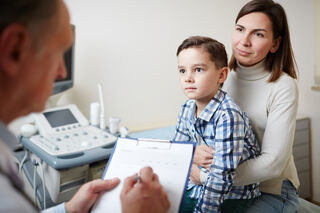Autism
Autism and the Danger of Cure Fads
A parent's perspective on the impact of cure fads on their parenting journey.
Posted November 30, 2022 Reviewed by Gary Drevitch
Key points
- Despite rising rates of autism diagnosis, parents experience much uncertainty about whether autism is a disorder and whether it is curable.
- Parents of newly-diagnosed children can come across a variety of information online that impacts where they focus their resources.
- Cure fads can hold parents back from an experience of acceptance, as well as from focusing on advocacy and therapeutic efforts.

Autism is a genetic, neurological condition that affects social communication, the processing of information, and behavior (DMS V, 2013).
Autistic individuals generally communicate in different ways than their neurotypical peers: For example, they may read implicit nonverbal body language in a different way than neurotypical peers (Kana et al., 2016). Their repetitive behaviors may include an intense attachment to a particular special interest or may be expressed through a strong need for routine and structure (DMS V, 2013). The current diagnostic criteria for autism spectrum disorder (ASD) also include hyper- or hypo-sensitivity to sensory input (DMS V, 2013), such as finding it challenging to filter out irrelevant noises in a shopping center or experiencing sensitivity to touch.
Despite rates of autism diagnosis rising across the globe due to the rise in awareness of the condition and advances in testing (McDonald et al., 2012), autism continues to be enshrouded in uncertainty. Questions I frequently hear from parents are: Is autism curable? Is it a disorder? When will science discover its exact genetic causes? Will my child’s autistic characteristics change over time?
The human brain finds uncertainty or the unknown uncomfortable.
Science, thus far, does not know the exact genetic causes of autism. Twin and sibling studies point to strong genetic heritability. The sibling rate of recurrence of the autism diagnosis is between 18.7 to 47 percent (Vohs, 2019), with this rate increasing to 60-100 percent in the case of twins (Vohs, 2019). However, there are hundreds of genes identified as predisposing one to ASD, affecting different neurobiological processes (Vohs, 2019).
Like many parents of newly diagnosed children, I initially coped with the complexity and uncertainty surrounding autism by turning to Google in search of answers to the many questions I had about my child’s developmental potential. I found a variety of conflicting information, including advertisements about alternative interventions ranging from elimination diets to fidget spinners and anecdotal accounts that claimed to have cured autism. I was not alone in my quest. Research suggests that up to 95 percent of parents look into alternative treatments for their children (Hofer et al., 2019).
Some emerging therapies, such as music therapy or mindfulness interventions, have promising results and simply require more substantiated evidence to boost their level of recommendation. Others, such as gluten-free or casein-free diets, lack consistent evidence of effectiveness (NAC, 2015).
Over time, I experimented with many alternative therapies and supplements. I also accrued a deeper understanding of how my son experienced the world and came across increasingly more neurodiverse perspectives of people on the autism spectrum themselves, as they are becoming increasingly present in research.
A pivotal moment along my parenting journey
I remember pausing amidst supporting my son with his homework and appreciating that “this is not going away.” I realized that the characteristics I loved about him, including those associated with being on the autism spectrum, such as taking things literally, being honest and direct, or seeing the details of a situation, are likely to be our ongoing companions (e.g., research finds that detailed-oriented cognitive style has been persistent in individuals on the autism spectrum across time (Bojda et al., 2021)).
I finally figured out where I wanted and needed to focus my attention: on acceptance, on advocacy around how the school environment can support my child’s needs (e.g., through breaking down tasks and offering visual support), and on my child’s emotional learning (supporting my son’s awareness of implicit emotion by making it explicit and deepening his practice of coping).
Parents value access to accurate information about autism for themselves and for people involved in the education and care of their children (Clarks and Adams, 2020), especially at the time of initial diagnosis. Accurate information is crucial for deciding the very next steps they will take and where they will focus their energy and resources.
Looking back, I would have liked to have been told that autism is a genetic condition that comes with many strengths as well as challenges—and that there is much learning that happens in the process of early intervention that influences the trajectory of how the characteristics of my child will unfold, and that acceptance from loved ones is associated with better mental health outcomes and is something my child needs the most.
Especially at the time of diagnosis, parents need support, encouragement, and advice to consult leading autism support organizations such as National Autism Center (NAC), Autism Spectrum Australia (ASPECT), Positive Partnerships, or Organization for Autism Research, which can offer them evidence-based information and guidance.
References
Bojda A., Srebnicki T., Konowałek Ł., Bryńska A. (2021). Weak central coherence - construct conception, development, research methods. Psychiatr Pol, 55(6), 1373─1386. https://doi: 10.12740/PP/OnlineFirst/120931
Clark, M., & Adams, D. (2020). Listening to parents to understand their priorities for autism research. PloS One, 15(8), e0237376–e0237376. https://doi.org/10.1371/journal.pone.0237376
Diagnostic and statistical manual of mental disorders : DSM-5 (Fifth edition.). (2013). American Psychiatric Association.
Höfer, J., Hoffmann, F., Kamp-Becker, I., Küpper, C., Poustka, L., Roepke, S., Roessner, V., Stroth, S., Wolff, N., & Bachmann, C. J. (2019). Complementary and alternative medicine use in adults with autism spectrum disorder in Germany: results from a multi-center survey. BMC Psychiatry, 19(1), 53–53. https://doi.org/10.1186/s12888-019-2043-5
Kana, R. K., Patriquin, M. A., Black, B. S., Channell, M. M., & Wicker, B. (2016). Altered Medial Frontal and Superior Temporal Response to Implicit Processing of Emotions in Autism. Autism Research, 9(1), 55–66. https://doi.org/10.1002/aur.1496
National Autism Center. (2015). Findings and conclusions: National standards project, phase 2. Randolph, MA. Author. https://www.nationalautismcenter.org/national-standards-project/results…
McDonald, M. E., Pace, D., Blue, E., & Schwartz, D. (2012). Critical Issues in Causation and Treatment of Autism: Why Fads Continue to Flourish. Child & Family Behavior Therapy, 34(4), 290–304. https://doi.org/10.1080/07317107.2012.732849
Vohs, A.M. 2019, Recurrence Rate and Phenotypical Similarities in Siblings Diagnosed With Autism Spectrum Disorders, University of Colorado at Denver.




